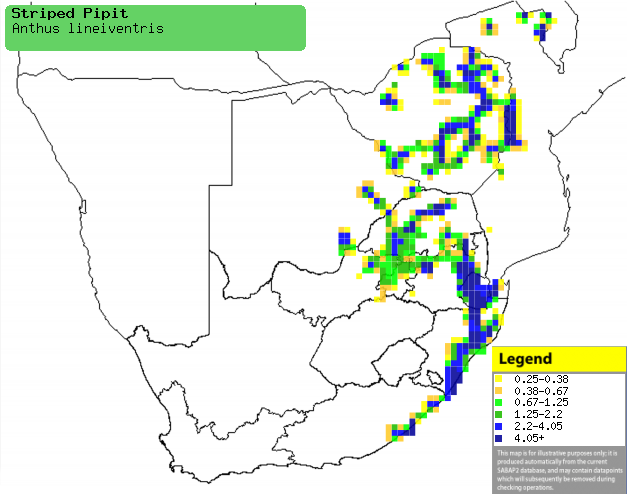|
Anthus lineiventris (Striped
pipit)
Gestreepte koester [Afrikaans]; Intsasana [Xhosa];
Gestreepte pieper [Dutch]; Pipit de Sundevall [French]; Streifenpieper
[German]; Petinha-estriada [Portuguese]
Life
> Eukaryotes >
Opisthokonta
> Metazoa (animals) >
Bilateria >
Deuterostomia > Chordata >
Craniata > Vertebrata (vertebrates) > Gnathostomata (jawed
vertebrates) > Teleostomi (teleost fish) > Osteichthyes (bony fish) > Class:
Sarcopterygii (lobe-finned
fish) > Stegocephalia (terrestrial
vertebrates) > Tetrapoda
(four-legged vertebrates) > Reptiliomorpha > Amniota >
Reptilia (reptiles) >
Romeriida > Diapsida > Archosauromorpha > Archosauria >
Dinosauria
(dinosaurs) > Saurischia > Theropoda (bipedal predatory dinosaurs) >
Coelurosauria > Maniraptora > Aves
(birds) > Order: Passeriformes
> Family: Motacillidae > Genus: Anthus
Distribution and habitat
Occurs in patches from southern Kenya through Tanzania,
Zambia, southern DRC and Malawi to southern Africa. Here it is uncommon to
fairly common in northern Mozambique, Zimbabwe, south-eastern Botswana, eastern
South Africa and Swaziland, generally preferring woodland on the steep slopes of
mountains, hills and gorges, especially miombo (Brachystegia) woodland
but also Afromontane forest and alien tree plantations.
|
 |
|
Distribution of Striped pipit in southern Africa,
based on statistical smoothing of the records from first SA Bird Atlas
Project (©
Animal Demography unit, University of
Cape Town; smoothing by Birgit Erni and Francesca Little). Colours range
from dark blue (most common) through to yellow (least common).
See here for the latest distribution
from the SABAP2. |
Food
It does most of its foraging between rocks on the ground,
in sparse vegetation and on roadsides, feeding on insects such as grasshoppers (Orthoptera)
and other invertebrates, including ticks (Amblyoma).
Breeding
- The nest is a cup of dry grass, leaves and twigs, lined with fine grass
and rootlets. It is typically placed on level ground against a rock or dead
grass tuft, or alternatively on a low bank among ferns.
- Egg-laying season is from September-January, peaking from
October-December.
- It lays 2-3 white eggs, heavily speckled with brown and grey.
Threats
Not threatened.
References
-
Hockey PAR, Dean WRJ and Ryan PG 2005. Roberts
- Birds of southern Africa, VIIth ed. The Trustees of the John Voelcker
Bird Book Fund, Cape Town.
|
